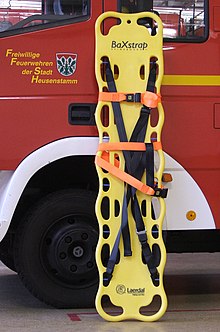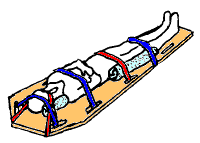Spineboard
The spineboard , also called millerboard or backboard , depending on the manufacturer , is an aid for rescuing injured people who could injure the spine. The spineboard consists either of wood or of hard plastic and plastic composite material, depending on the manufacturer 150 to 1100 kilograms of load capacity are specified. It is usually completely radiolucent and computed tomography - or MRI -suitable. For rigid lightweight construction, it is hollow or foamed on the inside and therefore buoyant and provides a little buoyancy and thus also favorable for water rescue .
Shape and dimensions
A length of 183 cm and a width of 40 to 45 cm with a weight of six to seven kilograms is typical. Shorter types only fix the head and trunk of an adult up to the pelvis. There are numerous grip slots all around, which can also be used for belting. Boards can be flat or slightly curved upwards on the longitudinal edges. A curvature stiffens the board, helps to fix the person on it and makes it easier to reach under on level ground. The underside is smooth or equipped with longitudinal runners so that it can slide easily over ladders or stairs or be rotated on a railing, the height is four to five, with runners even six centimeters. To fix the head against rotation, extra belt loops, wedges and straps can be built up.
application
Similar to the scoop stretcher , the spineboard is pushed under the patient or the patient is lifted onto it. The patient can be rotated axially with several helpers so that the spineboard can be positioned behind his back. Then the spineboard and the patient are brought back into the supine position. Then it must be secured with a head restraint set and a multi-part belt set or with a patient restraint system (also known as a "spider") and is ready for transport. Another application is patient-friendly rescue from motor vehicles. After removing the car roof, the board is pushed between the patient and the seat and the patient is then pulled axially onto the board with several helpers. When the patient lies on the board in full length, it is brought back to the horizontal and the patient can be lifted out of the vehicle. Also, due to the numerous grip options, spineboards are ideal for rescuing people from rough terrain.
When rescuing accident victims with suspected injury to the spine or brain, immobilization with the spineboard in combination with a head restraint or the use of vacuum mattresses is internationally recognized as the gold standard of pre-clinical care and transport.
disadvantage
In addition to the indisputable advantages of immobilizing accident victims with suspected spinal injuries, side effects and disadvantages have also been published that increase with the duration of the immobilization. Pain, pressure ulcers , increased intracranial pressure , extension of the inpatient stay and difficulties during the clinical examination are mentioned. Extension of the hospital phase, difficulties with intubation and the risk of fracture dislocation in older patients are also mentioned.
The trauma surgeon in the clinic should therefore remove the spine board as soon as possible. In practice, diagnostic imaging ( X-ray , computed tomography , MRT ) is often performed with immobilization. A systematic analysis of CT images with an X-ray phantom showed no artifacts from the spine board, but from head fixations. Even head fixations made of soft foam plastic made artifacts.
Availability
In most German rescue equipment , the spineboard is not carried because here, in contrast to other countries such as z. B. the USA, usually with a scoop stretcher and vacuum mattress . However, the spineboard has also become increasingly popular recently.
Other German aid organizations, such as the Deutsche Lebens-Rettungs-Gesellschaft , the water rescue service or many volunteer fire brigades , have purchased floatable spineboards for water rescue, among other things, and keep them in their vehicles. The fact that the spineboard can also be used in water is an advantage here, as the board can simply be pushed under the patient. Here it is primarily used to fix the patient for bringing on board or transport with the motor lifeboat or as a stretcher for landing.
In addition, the state of North Rhine-Westphalia has equipped the MANV roll-off containers and the medical equipment trolleys of the disaster control with spineboards. The state of Rhineland-Palatinate has implemented the provision on all ambulances. The Federal Office for Civil Protection and Disaster Assistance has also decided to carry five spineboards on each of the medical equipment trolleys it has procured - as has the Free State of Bavaria.
Individual evidence
- ↑ a b A board for the spine. ( Memento from June 6, 2014 in the Internet Archive ) (PDF file; 506 kB), Rettungsmagazin 2005, p. 44ff.
- ^ MW Cooke: Use of the spinal board within the accident and emergency department. In: Emergency Medicine Journal . tape 15 , no. 2 , March 1, 1998, ISSN 1472-0205 , p. 108-109 , doi : 10.1136 / emj.15.2.108 , PMID 9570052 , PMC 1343036 (free full text).
- ^ MHA Malik, ME Lovell: Current spinal board usage in emergency departments across the UK . In: Injury . tape 34 , no. 5 , 2003, p. 327–329 , doi : 10.1016 / S0020-1383 (02) 00314-5 ( elsevier.com [accessed August 27, 2019]).
- ^ A b Thomas Adam Purvis, Brian Carlin, Peter Driscoll: The definite risks and questionable benefits of liberal pre-hospital spinal immobilization . In: The American Journal of Emergency Medicine . tape 35 , no. 6 , 2017, p. 860–866 , doi : 10.1016 / j.ajem.2017.01.045 ( elsevier.com [accessed August 27, 2019]).
- ↑ Wietske HW Ham, Lisette Schoonhoven, Marieke J Schuurmans, Luke PH Leenen: Pressure ulcers, indentation marks and pain from cervical spine immobilization with extrication collars and headblocks: An observational study . In: Injury . tape 47 , no. 9 , 2016, p. 1924–1931 , doi : 10.1016 / j.injury.2016.03.032 ( elsevier.com [accessed August 27, 2019]).
- ↑ Greg Nemunaitis, Mary Joan Roach, Mohamed Samir Hefzy, Melvin Mejia: Redesign of a spine board: Proof of concept evaluation . In: Assistive technology: the official journal of RESNA . tape 28 , no. 3 , 2016, ISSN 1949-3614 , p. 144–151 , doi : 10.1080 / 10400435.2015.1131759 , PMID 26852872 .
- ^ PJ Rao, K Phan, RJ Mobbs, D Wilson, J Ball, S Wales, et al .: Cervical spine immobilization in the elderly population. In: Journal of Spine Surgery . tape 2 , 2016, p. 41-46 .
- ↑ Christian Maschmann, Elisabeth Jeppesen, Monika Afzali Rubin, Charlotte Barfod: New clinical guidelines on the spinal stabilization of adult trauma patients - consensus and evidence based . In: Scandinavian Journal of Trauma, Resuscitation and Emergency Medicine . tape 27 , no. 1 , 2019, ISSN 1757-7241 , doi : 10.1186 / s13049-019-0655-x , PMID 31426850 , PMC 6700785 (free full text).
- ↑ EB Lerner, R Moscati: Duration of patient immobilization in the ED . In: The American Journal of Emergency Medicine . tape 18 , no. 1 , 2000, ISSN 0735-6757 , p. 28-30 , PMID 10674527 .
- ↑ Baukje Hemmes, Cécile RLPN Jeukens, Aliaa Al-Haidari, Paul A M. Hofman, Ed S Vd Linden: Effect of spineboard and headblocks on the image quality of head CT scans . In: Emergency Radiology . tape 23 , no. 3 , 2016, ISSN 1438-1435 , pp. 263–268 , doi : 10.1007 / s10140-016-1396-z , PMID 27091739 , PMC 4875944 (free full text).

